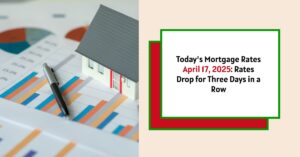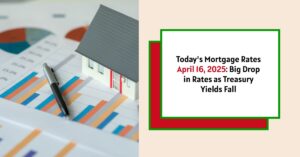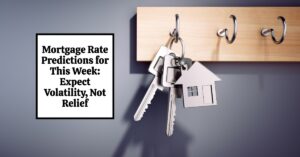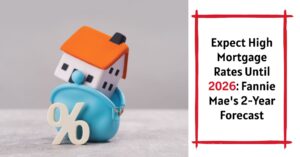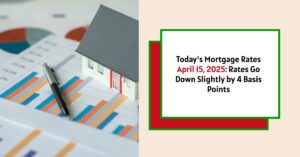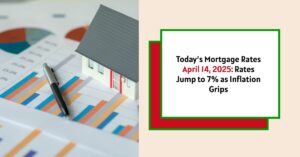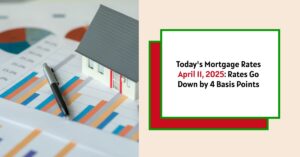On April 17, 2025, mortgage rates have slightly decreased for the third consecutive day, providing some relief for prospective homebuyers and refinancers amid ongoing economic uncertainties. The current average 30-year fixed mortgage rate stands at 6.74%, whereas the 15-year fixed is at 6.06%. Refinance rates mirror this trend, with the 30-year fixed refinance at 6.76% and the 15-year at 6.12%. These rates, though still higher than historic lows, are trending down, signaling potential opportunities for those aiming to lock in favorable borrowing costs in a volatile market.
Today's Mortgage Rates April 17, 2025: Rates Drop for Three Days in a Row
Key Takeaways
- Mortgage rates are falling for the third straight day, with prominence on the 30-year fixed and 15-year fixed rates.
- The average 30-year fixed mortgage is at 6.74%, and refinance rates are around 6.76%.
- Variable-rate loans, like ARMs, remain near 7%, offering alternatives to fixed-rate loans.
- Market fluctuations are driven by economic signals, including tariffs, inflation, and Treasury yields.
- Economic forecasts suggest mortgage rates might stabilize around 6% by 2026, but volatility remains.
Current Mortgage Rates: Snapshot of April 17, 2025
| Loan Type | Interest Rate | Details |
|---|---|---|
| 30-year fixed | 6.74% | The most popular fixed-rate mortgage. |
| 20-year fixed | 6.58% | Slightly shorter term with a slightly lower rate. |
| 15-year fixed | 6.06% | Pays off faster, with lower interest over time. |
| 5/1 ARM | 6.99% | Adjustable rate, fixed for first 5 years. |
| 7/1 ARM | 7.27% | Fixed for 7 years, then adjusts annually. |
| 30-year VA | 6.31% | For veterans, generally lower. |
| 15-year VA | 5.84% | Short-term VA fixed-rate loan. |
| 5/1 VA | 6.32% | VA adjustable rate, first 5 fixed. |
Refinance Rate Trends
| Loan Type | Interest Rate | Notes |
|---|---|---|
| 30-year fixed | 6.76% | Slightly higher than purchase rate. |
| 20-year fixed | 6.59% | Same as current purchase rate for 20-year. |
| 15-year fixed | 6.12% | Lower than 30-year refinance. |
| 5/1 ARM | 6.96% | Slightly higher, reflecting market volatility. |
The rates are averages sourced from Zillow and other leading financial sources, reflecting nationwide data.
Deeper Insight into Mortgage Rates
While these numbers might seem straightforward, understanding what influences them is crucial. Mortgage rates are affected by a mixture of controlled and uncontrollable factors.
Controlled Factors:
- Credit score—higher scores tend to fetch lower rates.
- Down payment—larger payments overall can secure better terms.
- Comparison shopping among lenders—many lenders offer slightly different rates and fees.
Uncontrollable Factors:
- Overall economic health as indicated by employment rates and inflation.
- Treasury yields, especially the 10-year Treasury note, which serve as benchmarks.
- Geopolitical developments, tariffs, and trade policies often induce market volatility affecting mortgage rates.
Why Are Rates Falling Now?
The recent decline, after a spike to 7% last week, is likely influenced by a retreat in Treasury yields, which have eased amid economic data release and changing expectations of monetary policy. The Federal Reserve's approach appears to be cautious, with signals that they are “not in a hurry” to raise or lower rates (Fannie Mae Forecast). This cautious stance fosters some short-term rate stabilization.
Looking ahead, most forecasts anticipate mortgage rates settling between 6% and 6.5% by the end of 2025, with some models projecting rates slightly lower in 2026. Freddie Mac expects rates around 6.3% for the rest of 2025 on average, aligning with Fannie Mae’s outlook. This stabilization is a positive sign for borrowers, especially considering the volatile environment caused by tariffs and inflation concerns.
Types of Mortgages and Their Pros & Cons
Fixed-Rate Mortgages
Advantages:
- Stable payments over the loan term.
- No surprises, easier budgeting.
- Typically lower interest rates for shorter terms like 15 years.
Disadvantages:
- Higher monthly payments compared to adjustable options.
- Might miss out on falling interest rates.
For example, a $300,000 mortgage at 6.74% over 30 years would cost approximately $1,950/month (principal & interest), whereas the same loan over 15 years at 6.06% would be about $2,545/month.
Adjustable-Rate Mortgages (ARMs)
Advantages:
- Lower initial rates, often making payments more affordable early on.
- Potential to benefit if interest rates decline in the future.
Disadvantages:
- Payments can increase after initial fixed period.
- Market uncertainty may lead to unpredictable payments over time.
Given current rates, ARMs are less attractive if rates stay steady or rise, but they are still viable for short-term buyers.
Read More:
Mortgage Rates Trends as of April 16, 2025
Mortgage Rate Predictions for This Week: Expect Volatility, Not Relief
Mortgage Rates Likely to Go Down in the Short Term Due to Tariffs
Refinancing Trends and Strategies
Refinancing is an attractive option, especially when rates are falling, as they are now. Borrowers consider refinancing to:
- Lower monthly payments.
- Switch from adjustable to fixed rates.
- Tap into cash with cash-out refinancing.
- Shorten loan terms to save on interest.
Notably, the refinance rate (6.76%) is marginally higher than purchase rates, primarily due to market liquidity and the additional costs associated with refinancing. Still, current rates are low enough to make refinancing an appealing move for many.
The decision to refinance depends on individual circumstances, but with rates trending downward, it offers a window for significant savings. It's essential for borrowers to compare refinance offers across lenders and ensure that the long-term benefits outweigh closing costs.
Impacts of Market and Economic Conditions
The current cautious outlook stems from several economic signals. Inflation persists at elevated levels, yet the Federal Reserve suggests that rate hikes might pause, resulting in a delicate balancing act. Tariffs and trade policies continue to inject uncertainty, causing market swings.
Mortgage rates are inherently linked to the overall health of the economy. In times of economic weakness, rates tend to fall to encourage borrowing, while during strong growth periods, they tend to rise. Currently, the market is navigating these conflicting signals, hence the recent downward trend.
Summary of Rate Predictions and Market Sentiment
While the current rates provide an opportunity, experts agree that rates probably won't dip back to the historic lows of below 3% seen in 2020-2021. Instead, a more moderate range around 6% seems likely for the near future, with some forecasts hinting at gradual declines toward 6.1% – 6.3% by late 2025.
The pace of economic growth, inflation trends, and Federal Reserve policies will continue to influence the trajectory. The key for potential borrowers is to monitor these variables closely and act when market conditions align with their financial goals.
FAQs about Today's Mortgage Rates – April 17, 2025
1. Are mortgage rates expected to drop further in 2025?
Most analysts forecast mortgage rates will remain relatively stable or slightly decline, averaging around 6% to 6.3% by the end of 2025. However, economic factors such as inflation, trade policies, and Federal Reserve actions could influence these trends.
2. Should I rush to buy a home before rates rise again?
Timing the market is challenging, but if your financial situation is stable and you find favorable rates, acting sooner rather than later might save you money. However, it’s essential to consider your personal circumstances and consult with a financial advisor.
3. Is refinancing worth it with rates still above 6%?
Refinancing can be a good idea if it lowers your monthly payments or helps you eliminate private mortgage insurance (PMI). Even with rates above 6%, refinancing could still provide financial benefits, especially if you plan to stay in your home for several years.
4. What factors should I consider when choosing a mortgage lender today?
Compare interest rates, closing costs, loan terms, customer service reviews, and the lender’s reputation. It’s also wise to get quotes from multiple lenders to ensure you secure the best possible deal.
Work With Norada, Your Trusted Source for
Real Estate Investment in the U.S.
Investing in turnkey real estate can help you secure consistent returns with fluctuating mortgage rates.
Expand your portfolio confidently, even in a shifting interest rate environment.
Speak with our expert investment counselors (No Obligation):
(800) 611-3060
Also Read:
- Will Mortgage Rates Go Down in 2025: Morgan Stanley's Forecast
- Expect High Mortgage Rates Until 2026: Fannie Mae's 2-Year Forecast
- Mortgage Rate Predictions 2025 from 4 Leading Housing Experts
- Mortgage Rates Forecast for the Next 3 Years: 2025 to 2027
- 30-Year Mortgage Rate Forecast for the Next 5 Years
- 15-Year Mortgage Rate Forecast for the Next 5 Years
- Why Are Mortgage Rates Going Up in 2025: Will Rates Drop?
- Why Are Mortgage Rates So High and Predictions for 2025
- Will Mortgage Rates Ever Be 3% Again in the Future?
- Mortgage Rates Predictions for Next 2 Years
- Mortgage Rate Predictions for Next 5 Years
- Mortgage Rate Predictions: Why 2% and 3% Rates are Out of Reach
- How Lower Mortgage Rates Can Save You Thousands?
- How to Get a Low Mortgage Interest Rate?
- Will Mortgage Rates Ever Be 4% Again?
